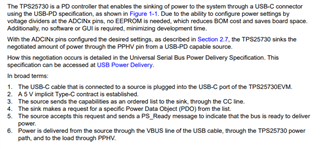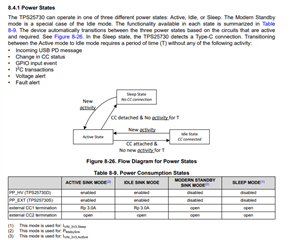Tool/software:
Hi All,
We are using the mentioned part above. We have done the pin strapping. We also want to monitor the device with I2C.
I still don't understand how to use this part. If I connect to a power source, would the power negotiation be automatic?
Do i have to initiate with a i2c command?
How do I check if the power negotiation was successful? ALSO, what does RX_SINK_CAPS Register and TX_SINK_CAPS registers mean and used for?
What are the other registers mean and used for ?
What are the differences between pdos?
How do i put the device to the sleep mode?
Do i have to do the pin strapping AND write to TX_SINK_CAPS?
I wish there were more explanation to these terms. I am a beginner in usb c controls, and i find it quite sad that, this part is just left out with no example code or app notes




